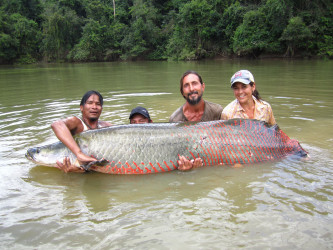Over time, numerous experts in a range of fields have come to Guyana and contributed expertise, training and sometimes equipment to various sectors of our economy. Occasionally, as in the case of donations to our medical facilities, we hear of these visits via the press, but most of the time the general public remains unaware of the beneficial role these specialists have played in our development. The individuals do their work and leave, and unless you are one of the few interacting with them during they stay, their contribution remains invisible.
Today I’m shining a little bit of light on one such contributor: in this case, a young woman, Lesley de Souza, born in Brazil and raised in the USA, who has been one of those generally invisible contributors to Guyana for going on 12 years now doing extensive work studying fish species here; in recent years she has moved to studying arapaima populations and behaviours, all over the Rupununi. Lesley’s work, initially of a purely biological nature, has been taking on a wider application since 2012 when she did research work for the village of Rewa which is venturing into the eco-tourism sphere using the catch-and-release approach to sport-fishing in their community. Lesley (no Guyanese connection),who is now a researcher with the John G. Shedd Aquarium in Chicago, came here initially in 2003 to do a study on fish populations in Guyana suggested by her university professor as the focus of her Ph.D. programme at Auburn University.


From 2012, Lesley’s research work on the arapaima intensified. She says: “The people at Rewa had stopped commercial harvesting of arapaima; they wanted to preserve their natural resources, and to develop their eco-tourism with a catch-and-release sport-fishing business. We needed to examine whether this was healthy for the species, and to understand more of their biology, so that it would be a sustainable business. For the past three years I’ve been coming to Rewa working on arapaima and helping to understand more about their movement patterns; to protect a species you have to understand what their patterns are so you know what area you need to protect, and, in this case, what is the impact of the sport-fishing on them.”
This work started in 2012 with a radio telemetry programme to track the movement of the fish in the rainy season– how far were they roaming; were they returning to their original location? Some impressive scientific studies had been done on the fish by Cynthia Watson, but little was known about their movement patterns. De Souza began that slant in 2012 using radio telemetry. A small battery-powered radio transmitter, the size of a double-A battery, is implanted in the body of the fish, which allows for a radio receiver in an airplane to track the fish’s movements. Lesley was trained by a veterinarian to do the implant surgery herself, on location.
Looking back on it, she admits to being somewhat “overwhelmed” as she arrived here for the first operation. To perform the surgery, they would catch an arapaima in a specially made net with a 5-inch opening to target arapaima. “Nobody had ever done this before. It was new, and the fish was bigger than me. But we practised on catfish that we ate, and then I gathered a crew from Rewa, we went up river and set up camp, and it began. I couldn’t have done it without them. The way the guys were handling the arapaima; they knew how to maneuver in the water. You’re dealing with a powerful fish. Its head is bony, and it’s a weapon; when they want to break free they can break bones. The focus, for the health of the fish and for our safety, was to do the implant as fast as we could – these fish are often 7 feet long and can weigh up to 300 pounds, so when they decide to go, they go.”
The arapaima are not anesthetized for the surgery. As in the accompanying photo, they are held in the water by the team, Lesley removes a few scales using pliers, makes the incision, inserts the transmitter, and finishes with sutures and tissue glue. She has to work fast. “It’s like when you turn a shark over on its back,” says de Souza. “The fish becomes placid for a while, almost catatonic, or disoriented, but when it’s ready to kick, look out.” After the first couple of surgeries (she ended up doing 30) she got the hang of it. The resulting telemetry data reveals the arapaima’s patterns. “Knowing their movements is essential,” says the researcher. “It will enable us to determine what extent of the river drainage they utilize in the rainy season when it floods, and determine critical feeding and breeding habitat. Movement data will also help to inform management plans for this species as protecting Arapaima has broader impacts, as a flagship species, and will thus preserve habitat with high biodiversity. What I’ve learned over the years in Rewa is that this fish is closely connected to the people. It is a symbol of their natural heritage, but it’s also their livelihood. The eco-tourism aspect is only recent, but arapaima has been part of their life for a long time. You can hear it in the way they speak of the fish.”
In the third year of the Rewa project, she is winding up work on the arapaima movement patterns, and turning to the health of the fish and at the sport-fishing impact on them. “I feel privileged and honoured to work alongside the Rewa villagers and learn from them, and seeing these young generations growing up as conservationists,” she said. “It’s inspiring.” Inspiring as well is the contribution that experts such as Lesley de Souza make to Guyana. They may remain invisible to most of us, but they are having powerful impacts in our country.





